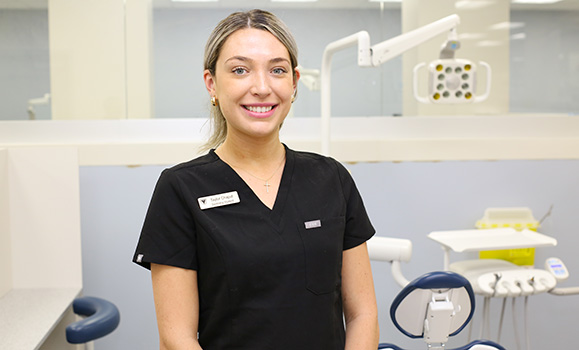This article is part of How I Spent My Summer, a series of articles showcasing what students got up to over the past few months -- from work-intergrated learning to mini-courses and more. Find more stories in the series at the bottom of this article.
When Taylor Chaput heard that she could spend seven weeks of the summer break between the second and third years of her Doctor of Dentistry (DDS) program taking a clinic observation elective, she seized the opportunity with gusto.
Dentistry students at Dalhousie typically spend the first two years of their program in the classroom and labs, learning the science and the hand skills they will need before they meet their first patient. Everything changes in third year when students make the transition to clinical practice and begin treating patients in the Faculty of Dentistry clinic.
For Chaput, the opportunity to spend part of the summer gaining clinic experience by watching and assisting senior dentistry students as they treated patients made good sense.
“In dentistry school, we only have about two years where we do hands-on clinical work. Our professors and instructors teach us as much as they can, but there will be things we have to learn on our own,” says Chaput. “I thought, what greater opportunity to learn from other students and be exposed to patients I might not otherwise be exposed to. So I applied.”
Putting learning into action
Chaput anticipated that she’d be watching the fourth-year students at work and being a “sponge” for information. At most, she thought she might be able to administer local anesthesia, which she had been taught to do.
But it was better than that. In fact, she was able to do three fillings herself. Chaput says she was nervous. “But I was also in good hands and, you know, you have to start somewhere.”
One of the fillings involved drilling out decay and discovering — as her professors had told her — that a real tooth is nothing like the plastic teeth Chaput had practised on. The other two restorations were on broken front teeth, which involved drilling, colour-matching and shaping the material used to rebuild the tooth.
In all cases, she had to ensure the repaired tooth was comfortable for the patients and that they were happy with the results.
“Seeing the before and after was a standout moment for me,” says Chaput. “I’ll definitely remember it later in my career. It went well, and I was proud of my work.”

In addition to the unexpected hands-on experience she gained, Chaput says she learned a lot about interacting with patients, particularly from Dr. Rick Raftus, one of the small group practice leaders. “He puts people at ease by being kind and just having normal conversations with them,” says Chaput.
Before doing the elective, Chaput says that interacting with patients was one of the scariest aspects of going into third year. “It means not just working on my typodont, which can’t talk to me, and not just taking notes on my laptop. We’re now putting what we learned into action and that’s a big leap in our responsibilities.”
Would she recommend the summer observation elective to other students? Chaput says it was a “no brainer” for her.
“Dentistry is hard and you can’t just learn it from a book,” she says. “You have to learn it with your hands, through your peers, and from the people who have been doing it for years. This experience taught me that. It will definitely help me to become my best version of Dr. Taylor Chaput in the future.”

